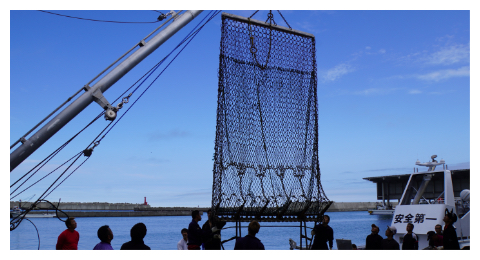- home
- Dried Seafood
- Catching & Drying Scallops
Fishing Ground of Scallop and Production Areas of Dried Scallop

The Sea of Okhotsk is the main fishing ground for scallops whose adductor muscles are dried for cooking. This sea off Hokkaido is a nutrient rich sea where a lot of plankton is carried in by drift ice flowing into it from the north in winter.
The Sea of Okhotsk is an extremely clean sea relative to other seas in the world due to the absence of major industrial sites on the east coast of Hokkaido. This unspoiled clean sea provides the ideal breeding ground for nutritious scallops full of flavor (umami), truly nourishing blessings of the sea.
Production facilities for dried scallops converge along the Okhotsk coast close to the fishing grounds, stretching from Soya in the north to Tokoro in the south. The live scallops fresh caught on the day are immediately processed and dried. Though there used to be 28 factories in the past, the number has gone down to roughly 20 plants at present due to various reasons.
Method of Catching Scallops
The scallop fishing in the Okhotsk coast off Hokkaido operates under a seabed ranching system. Scallop spat is cultured for one year and then released into the Sea of Okhotsk, left to grow for three years on the seabed, then harvested.


The fisheries cooperatives of the Okhotsk coast divide fishing zones in this sea area into four, with spat being released into a different area each year. In turn after three years, the 4-year old scallop is harvested. This seabed ranching system optimizes the use of fishing zones that are up to roughly 60 meters’ depth which is suitable for scallop to live and grow.
The harvesting method employed for scallops is that of dredging across the seabed with a net attached to a huge rake-like device called hasshaku.
(Aquaculture is used in Saroma Lake, where a hanging method is used for culturing spat in cages lowered into the sea.)
Fishing Season and Dried Scallop Production Season

The scallop season is slightly different for the northern and southern parts of the Sea of Okhotsk but it is roughly between March and November.
Between March and May is the fishing ground’s preparatory period. The seabed of the fishing zone where the spat is to be placed is prepared and improved. The scallop that escaped from being harvested the previous year as well as starfish, the scallop’s natural predator, are removed.
The leftover catch from the previous season does constitute a sizable quantity in itself. Full fishing operations start from June after ground preparation is finished and goes on until November.

After spawning in June, the Okhotsk scallops feed vigorously and have the biggest growth spurt during the period between July and September.
Most of the scallop harvested during the preparatory period at the start of the season is processed into frozen products. The full-scale production of dried scallop starts from around June when fishing goes into its main operational period.
It takes one to two months from when production starts until the final product comes off the line, making the processing season for dried scallops between June and December.
Dried Scallop Production Ratio

About 15 to 20% of the scallops harvested in the Sea of Okhotsk is processed into dried scallops.
Because there are now fewer dried scallop processing plants, even if the catch of scallops increases, we are unable to increase production output of dried scallops due to processing capacity bottleneck.









